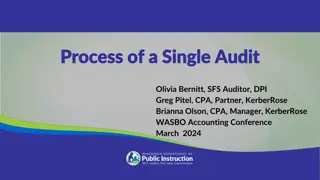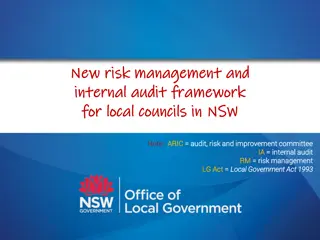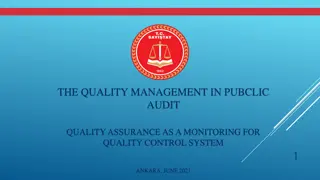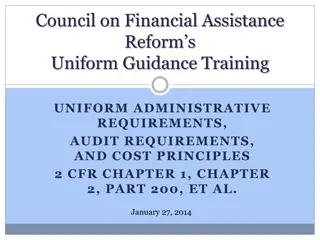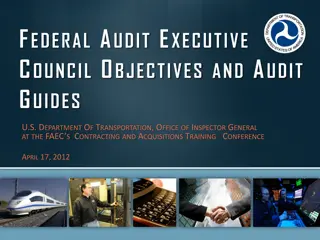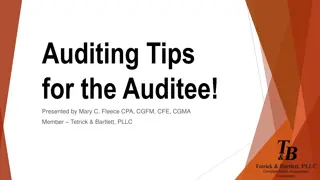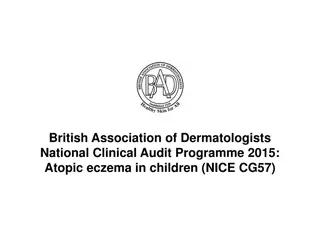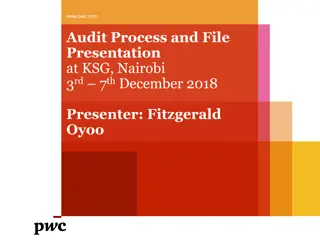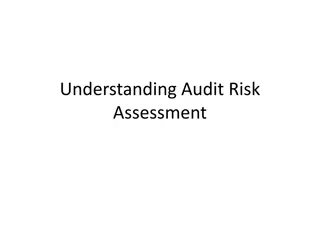Comparison of Financial Audit and Management Audit
Financial audit focuses on reviewing financial statements for accuracy and compliance, while management audit assesses the efficiency of operations and future planning. Financial audit is a legal requirement for registered companies, conducted by chartered accountants, and emphasizes error detection and prevention. On the other hand, management audit examines organizational objectives, structures, and policies to enhance management efficiency and future performance. Both audits play critical roles in ensuring transparency, accountability, and strategic planning within an organization.
Download Presentation

Please find below an Image/Link to download the presentation.
The content on the website is provided AS IS for your information and personal use only. It may not be sold, licensed, or shared on other websites without obtaining consent from the author. Download presentation by click this link. If you encounter any issues during the download, it is possible that the publisher has removed the file from their server.
E N D
Presentation Transcript
Points Financial Audit Management Audit Subject matter Review of financial aspect of business transactions represented through its profit & loss account and the balance sheet. Review of the past performance of the enterprise to examine the efficiency of almost every area of operation within the organisation. Object To ensure that the financial statements reflect the true and fair view of the state of affairs of the business. To review the efficiency of management in order to improve it. Base Based on financial statements. Based on managerial activity whether financial or non-financial.
Approach Examination of accounting records relating to previous year i.e. past financial year. Financial audit thus follows a backward looking approach. The approach of management audit is very dynamic and forward looking and mainly focuses its attention to future planning and performance after reviewing the past performance of the enterprise. Legal requirement Mandatory under the law of every company registered under the Companies Act 2013 or an earlier Companies Act. Not mandatory under the law. Concentration Detection and prevention of errors and frauds of financial nature. Appraisal of management policies and actions. Sequence Financial audit begins where the work of accountant ends. Management audit begins where the financial audit ends. Qualification of auditor A Chartered Accountant in practice or a firm of chartered accountants can assume the responsibility of conducting financial audit. There is no statutory qualifications to be possessed by a management auditor. It may be undertaken by any independent expert or consultant or internal auditors.
Appointment auditor of Financial auditor in case of joint stock company is generally appointed by members (shareholders) in the general meeting. Management auditor may be appointed by the board of directors on their sole descrition. Reporting Financial auditor reports to the members (shareholders) in the case of a company. Management auditor reports to the owner/management of the entity subjected to audit. Audit techniques Vouching of business transactions and verification and valuation of balance sheet items are primary techniques used by the financial auditor to form an opinion on the financial statements and accounts. Management auditor establishes the adequacy and reliability of procedures and internal control system in operation.
Scope of management audit 1. Appraisal of objectives:The management auditor has to appraise primary objectives of an organisation and the functional objectives i.e. secondary objectives which is referred to as subordinate objectives. He has to verify the following to appraise the objectives: a. Primary objectives i. clear and understandable to all the people concerned. ii. reasonable and can be achieved. iii. reflect on the responsibility of the organization towards shareholders, investors, suppliers and to society. b. Functional (secondary) objectives i. clear and understood by all the people of the organisation. ii. objectives are sub-divided into product goal, marketing goal, capital goal etc. iii. properly documented and are communicated to proper operating level. iv. Whether the objectives are in proper balance with each other.
Appraisal of organizational structure: Following points should be noted in the appraisal of organizational structure. i. The organizational structure is in harmony with objective of company division, department or unit. ii. Clear lines of responsibility from the top to bottom level. iii. reasonable span of management. iv. The structure should provide for unity of command. v. The structure has proper balance, i.e. no function should be excessively weak or excessively dominant. vi. The structure should be as simple and as economical as possible.
Appraisal of Control: control assures attainment of objective. There are two important aspect of control: i. Measurement of accomplishment against standard; and ii. Correction of deviations. Following points are of concern to management auditor: i. Whether good managerial practices were followed. ii. Whether management getting information relevant to decision and action. iii. Scientific decision making techniques were employed to the extent possible. iv. There exists a system for proper feed-back to determine whether or not a particular decision was correct.
Appraisal of Organizational Function: the management audit is not only confined with the management function (planning, organizing, controlling etc.) but also reviews the organizational function (production, distribution, personnel etc.). The following are to be carefully verified: a. Whether right quality of material at right quantity at a reasonable price and at a right time are made. b. Whether the procedure followed to determine right specification in a right time and at right price. c. Whether there is optimum utilization of installed capacity. d. Whether the inventory control methods are properly adopted for the purpose of improvement.
Conducting an audit 1. Enquiry 2. Examination 3. Direct observation 4. Review of internal audit reports 5. Physical inspection 6. Test examination of some transaction 7. Discussion with officials and employees
Prelimineries in conducting management audit Preliminary survey of organization Review of internal documentation Processing of Questionnaires Considering the criteria for Management Audit
Qualities of Management auditor Possess a complete knowledge of the various principles and concepts of management such as management by objectives, principles of delegation of authority and responsibility. knowledge about the various branch of accounting like financial accounting, cost accounting and management accounting. Have a general knowledge about the commercial laws like company law, tax law and industrial law. Have good communication skills and is a good listener so that he can collect the information from the management. He should have the power to understand the internal control devices that are used by the organisation. He should have the courage and loyalty to incorporate the various facts in his report and he should not change his report under pressure.
Corporate image Corporate image is the impression of the overall organisation held by the members of various society
Factors to be considered in evaluating Corporate Image Core business performance Financial performance Brand preference (Brand equity) Innovation and use of technological competency Policies towards employees and workers Dividend payment Business ethics Environment friendly
Developing corporate image Identification of forward-communicative moves through which image is communicated. Identification of the various section of the society which are relevant to the company for its growth. Product profile of the organization with emphasis on performance of different products.
Management auditor and corporate image Evaluation of proper criteria for the assessment of corporate image. He should form groups of different types of appraisal for this purpose. Management auditor must be related to the achievement of the organizational objectives and the contribution of the organisation towards the various sections of the society. It may be difficult for the management auditor to lay down or set procedure to be followed in all situation so he may follow any of the following approaches graphical method, point method etc. Evaluation of the performance of the organization by review of its control techniques and inter-firm comparison.
Social Cost Benefit Analysis (SCBA) SCBA is an analytical tool in decision making which enables systematic comparison to be made between the estimated social cost of undertaking a project and the estimated social value and benefits which may arise from the operation of such project.
SCBA procedure Determining the problem to be considered Ascertaining alternative solution to the problem Estimate and analyse the social cost and benefit Appraise the estimated social costs and benefits Decide on the optimal solution
Difficulties in SCBA Difficulty of measuring benefits Difficulty in scale problems Difficulties in estimating social costs (Cost estimating uncertainities and program uncertainities) Difficulty in determining total cost system




